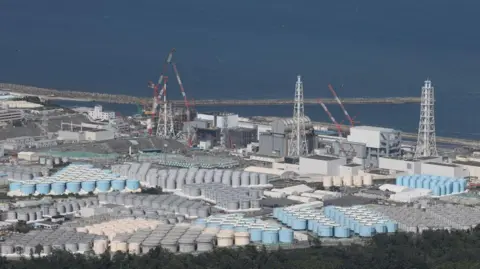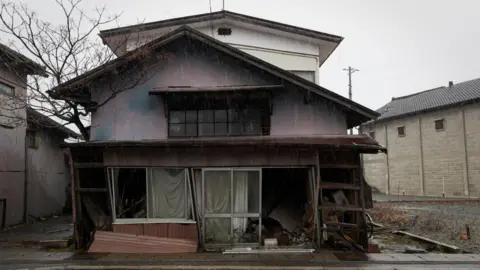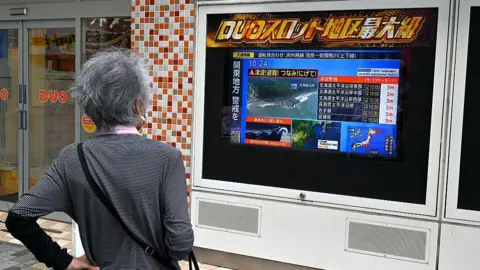 Getty Images
Getty ImagesWorkers at Japan’s embattled Fukushima nuclear plant were evacuated earlier on Wednesday after tsunami warnings were issued across the country.
The plant’s operator said all 4,000 of its workers had been evacuated, adding that there were no “abnormalities” detected.
It comes after a massive 8.7 magnitude earthquake struck off Russia’s far eastern coast, triggering warnings across the Pacific.
For many in Fukushima prefecture, the warning is likely to bring back memories of one of the worst nuclear disasters the world has seen.
In March 2011, Japan was hit by a devastating 9.0-magnitude earthquake and subsequent tsunami that went on to kill more than 18,000 people.
The tsunami flooded the plant, disabling its emergency generators and causing them to overheat – leading to a nuclear meltdown.
Hundreds of tons of extremely hazardous material still remain at Fukushima – and the challenges and controversies surrounding it are still very much present even now, more than 14 years later.
What happened at the Fukushima nuclear site?
On 11 March 2011 at 14:46 local time (05:46 GMT) an earthquake – known as the Great East Japan Earthquake – struck east of the city of Sendai, just 97km (60miles) north of the power plant.
Reactor buildings at Fukushima were damaged by hydrogen explosions caused by the earthquake and tsunami. The tsunami knocked out cooling systems to the reactors, three of which melted down.
The plant also suffered a number of chemical explosions which badly damaged the buildings, and to make matters worse, radioactive material began leaking into the atmosphere and the Pacific Ocean.
The government soon declared a 30km exclusion area around the plant, evacuating more than 150,000 people who were warned not to return due to radiation concerns.
Even now, significant portions of the area are still restricted – with abandoned homes, empty neighbourhoods and faded storefronts to show for it.
 Getty Images
Getty ImagesWhy is it so hard to clean up the nuclear waste?
A total of 880 metric tons of hazardous material – a mixture of melted nuclear fuel and reactor structures – still remain inside the Fukushima plant.
Removing this debris from the reactors is seen as the biggest challenge towards safely decommissioning the plant.
Tens of thousands of workers will be needed over the next 30 to 40 years to safely remove nuclear waste, fuel rods and more than one million tons of radioactive water still being kept at the site. The clean-up is also estimated to cost around 21.5tr yen ($145bn; 3109bn).
Earlier this week, Tepco said the start of full-scale removal of melted fuel debris would be pushed back until 2037 or later – saying that preparations for this would require at least 12-15 years.
The plan has already been delayed numerous times, and the latest delay is a major setback to a government plan to complete decommissioning by 2051.
Tepco still maintains that it can achieve this but some experts have called this into question.
“Who really believes all 880 tons of debris can be removed in 14 years between 2037 and 2051? Maintaining an unrealistic goal is not good when considering Fukushima’s recovery,” Shunji Matsuoka, a professor of environmental economics and policy studies at Waseda University, had told local news outlet Asahi.
And then there’s the issue of water.
Since the disaster, power plant operator Tokyo Electric Power Company Holdings (Tepco) has been pumping in water to cool down the reactors’ fuel rods. This means every day the plant produces contaminated water, which is stored in more than 1,000 tanks, enough to fill more than 500 Olympic swimming pools.
But Japan needs the land occupied by the tanks to build new facilities to safely decommission the plant – and in 2023, it began releasing some of this treated wastewater into the ocean.
The plan was met by a huge amount of criticism and controversy, despite the UN’s atomic regulators saying it will have a “negligible” impact on people and the environment.
Is Japan shifting back to nuclear power?
In the wake of the Fukushima disaster, Japan initially started moving away from nuclear energy – but the government has slowly started to reverse this policy.
Earlier this year, Japan said it needed to rely on nuclear to meet growing demand from power-hungry sectors like AI and semiconductors, with an energy plan released calling for “maximising” nuclear energy.
And this week, utility company Kansai Electric Power said it would look into whether it could build a new reactor – a project that had been suspended in the wake of Fukushima.
But there has been local opposition to such plans – and Wednesday’s tsunami alert is likely to heighten concerns.
Japan’s Meteorological Agency says tsunami waves have reached parts of the country’s coast, including Fukushima.
Waves could reach as high as 3m (9ft) in such areas and thousands have been told to evacuate for their safety.
 Getty Images
Getty ImagesWhy do so many earthquakes happen in Japan?
Japan’s precarious location on the Ring of Fire means it experiences about 1,500 earthquakes a year. The looming threat of earthquakes is ever present.
It is also widely considered to be among the most earthquake-prepared nations in the world. Its citizens begin taking part in earthquake drills from as early on as primary school and its buildings are designed to be earthquake resistant.
Despite this, many in Japan remain fearful of the “big one” – a once-in-a-century quake that worst case scenarios predict could kill as many as 300,000 people, triggering tsunamis of up to 30m (100ft) along the country’s Pacific coast.
Experts say there is a 70% to 80% chance of a magnitude 8 or 9 quake striking somewhere along Japan’s Nankai trough in the next 30 years.



